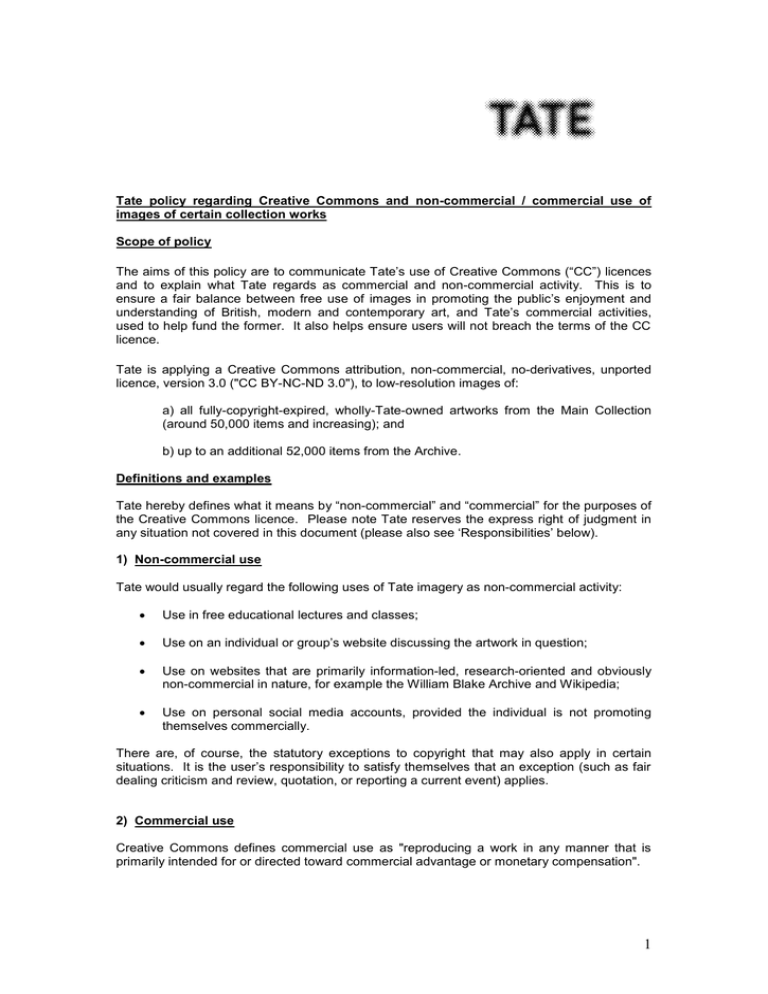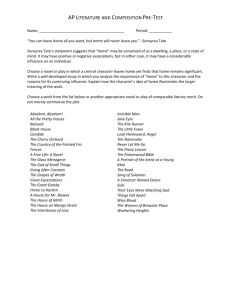Tate policy regarding Creative Commons and non
advertisement

Tate policy regarding Creative Commons and non-commercial / commercial use of images of certain collection works Scope of policy The aims of this policy are to communicate Tate’s use of Creative Commons (“CC”) licences and to explain what Tate regards as commercial and non-commercial activity. This is to ensure a fair balance between free use of images in promoting the public’s enjoyment and understanding of British, modern and contemporary art, and Tate’s commercial activities, used to help fund the former. It also helps ensure users will not breach the terms of the CC licence. Tate is applying a Creative Commons attribution, non-commercial, no-derivatives, unported licence, version 3.0 ("CC BY-NC-ND 3.0"), to low-resolution images of: a) all fully-copyright-expired, wholly-Tate-owned artworks from the Main Collection (around 50,000 items and increasing); and b) up to an additional 52,000 items from the Archive. Definitions and examples Tate hereby defines what it means by “non-commercial” and “commercial” for the purposes of the Creative Commons licence. Please note Tate reserves the express right of judgment in any situation not covered in this document (please also see ‘Responsibilities’ below). 1) Non-commercial use Tate would usually regard the following uses of Tate imagery as non-commercial activity: Use in free educational lectures and classes; Use on an individual or group’s website discussing the artwork in question; Use on websites that are primarily information-led, research-oriented and obviously non-commercial in nature, for example the William Blake Archive and Wikipedia; Use on personal social media accounts, provided the individual is not promoting themselves commercially. There are, of course, the statutory exceptions to copyright that may also apply in certain situations. It is the user’s responsibility to satisfy themselves that an exception (such as fair dealing criticism and review, quotation, or reporting a current event) applies. 2) Commercial use Creative Commons defines commercial use as "reproducing a work in any manner that is primarily intended for or directed toward commercial advantage or monetary compensation". 1 Tate further defines commercial use as “use on or in anything that itself is charged for, on or in anything connected with something that is charged for, or on or in anything intended to make a profit or to cover costs.” As well as obviously commercial activities such as merchandise production, use of Tate images editorially in films and on TV, in publications that are sold, in advertisements and commercial promotions, Tate would usually regard the following uses of Tate imagery as commercial activity: Use online or in print by commercial organisations, including (for the avoidance of doubt) trading arms of charities; Use on an individual’s website in such a way that adds value to their business, or for promotional purposes, or where offering a service to third parties; Use of images by university presses in publications online or in print; Use in publicity and promotional material connected with commercial events; Unsolicited use of images by news media, including front covers and centre-page spreads; Use in compilations of past examination papers; Use by commercial galleries and auction houses. Under charity law, conflicts can arise when one charity is seen as assisting another. Therefore Tate needs to treat other charities (and their trading arms) as if they were “commercial” organisations. Legal basis of policy Copyright, Designs and Patents Act 1988 (as amended), effective from 01 August 1989; Creative Commons (‘CC’) licence type CC BY-NC-ND, 3.0, unported – see http://creativecommons.org/licenses/by-nc-nd/3.0/legalcode; Museums and Galleries Act, 1992. Statement of principles As part of its mission to promote the public’s enjoyment and understanding of British, modern, and contemporary art, Tate wishes to make certain images available free of charge for re-use for non-commercial purposes. Tate sees CC licences as a well-established means of doing so, whilst balancing the needs of Tate’s own commercial / self-funding interests. Responsibilities The Board of Trustees of the Tate Gallery is the legal entity which owns Tate’s copyright and the body ultimately responsible for releasing material under a CC licence, as well as defining what Tate regards as commercial and non-commercial. The Head of Digital and the Intellectual Property Manager are jointly responsible for recommending this policy to the Trustees, for implementing the policy, and for determining and supervising workflows to ensure CC licences are attached to the relevant content and the policy delivered. 2 The Tate Images Manager and the Intellectual Property Manager will be jointly responsible for monitoring use of Tate’s CC content. Tate reserves the right to adjudicate on uses not covered in this document. A senior officer such as the Managing Director, in discussion with the Tate Images Manager and Intellectual Property Manager, will have executive adjudication in difficult cases. Breach of policy Tate takes breaches of its CC licences very seriously. In addition also to being infringements of Tate’s copyright, such breaches are also likely directly to threaten Tate’s commercial interests, which help fund Tate’s ‘free’ activities. Breaches are also grossly unfair to legitimate CC licence users. In the event of a potential breach of Tate’s CC licence terms, the Tate Images Manager will initially request potential violators to remove images and / or to obtain a commercial licence for use of the Tate images in question. Non-compliant users will thereafter be referred to the Intellectual Property Manager, and then to lawyers in Tate’s Legal department if necessary. Queries Any queries should be addressed to creativecommons@tate.org,uk. Review This policy will initially be reviewed one year after approval and thereafter every three years. Date of approval 21 January 2015 3

